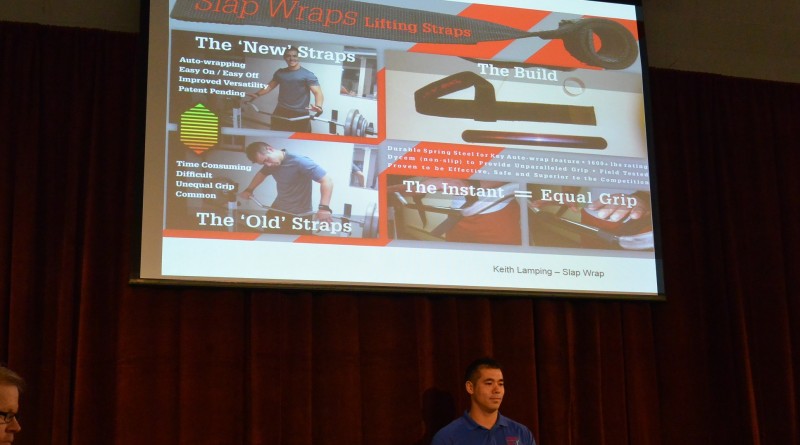UD Business Plan Competition calls on students to make dreams reality
By: Dominic Sanfilippo – Staff Writer
Ideas move the world. They come out of nowhere and can take over the rhythm of a person’s ordinary life, as visions and possibilities emerge of how life could be different.
However, many ideas stay dormant in our minds, filed away and often forgotten about. What does it look like to take an idea and attempt to make it reality?
The University of Dayton Business Plan Competition is a three-round competition that presents an opportunity for ambitious students to win funding for their business plans.
The first round of the competition, which is open to non-UD students, took place on Oct. 24. During this “elevator pitch” round students were afforded one minute and only a single PowerPoint slide to persuade the judges that their proposed businesses deserved funding.
For senior and UD Business Plan competitor Jessica Kerr, inspiration struck on an ordinary car ride with one of her best friends and roommate, Marissa Sander.
“I wanted to work on something different this year for the competition, something a little more personal,” Kerr said, an entrepreneurship, marketing and leadership triple major. “We [Marissa and I] were driving one day, and all of the sudden, the idea just clicked.”
“Marissa has cystic fibrosis. She’s always driving to Cincinnati for these PFTs [pulmonary function tests], which measure how her lungs are functioning,” Kerr explained. “She’s very healthy for someone with cystic fibrosis, thankfully, so every time she makes the trip, the doctors will just say, ‘You’re healthy.’
“She drives there and doesn’t really need it. However, she can’t miss the tests, because there might come a time when she really does need it.”
That’s where Aer (pronounced “air”) comes in. The device would effectively be a home version of the PFT tests that measures lung function and would send results to doctors instantly, who could then determine whether a visit to the hospital was necessary.
“Taking the test at home would save so much time and energy,” Kerr noted. “Since locations like Cincinnati Medical Center, which have the necessary PFT equipment, are few and far between, people with cystic fibrosis sometimes travel hundreds and thousands of miles to check in.”
“[Aer] would make life tremendously easier,” Sander said, a senior psychology major from Cincinnati. “Having a device that could measure my lung function without having to drive long hours would be so convenient…it would help a lot of CF [cystic fibrosis] patients who live far from a doctor and who are busy. For CF college students, especially, [Aer] would save many patients from hospitalizations.”
Kerr took fourth place in the elevator pitch portion of the competition, won this year’s Ernst and Young Women-in-Entrepreneurship award for her pitch and will be advancing to the next round of the competition, which will be held on Nov. 21.
The next “cameo” stage will pit 10 teams of students and young professionals from across the country against one another to make their case for why their idea deserves funding, with the final stages of the competition extending into the spring. In the cameo round, Kerr and others will have to dive into the substance and the smaller details of their business models.
“I’ll have five minutes to talk through how I’d make relationships with distributors, how to get Aer into pharmacies, why it’ll work and why this is the right time to make this product,” Kerr said. “The judges also have five minutes to ask any questions they want, which can make you a bit nervous.”
Kerr is not the only UD student to advance to the next stage of the competition.
Kaitlyn Roberts, a sophomore business student, won $2,500 for the Top Sustainability/Green Technology Idea Award and will be moving forward with her idea for PowerSage, which would help temporary residents monitor their energy usage in their apartments or homes.
Keith Lamping, a UD doctoral student in physical therapy, took first place in the elevator pitch round with SlapWrap, an efficient powerlifting support strap that is already patent-pending. According to his pitch video on UD’s YouTube channel, Lamping’s team has received overwhelming amounts of orders for SlapWrap after its first production batch sold out.
Kerr credits the entrepreneurship major and the L. William Crotty Center for Entrepreneurial Leadership for helping foster opportunities for growth and real-world success so early on for students. These two programs are consistently ranked in the top 20 entrepreneurship programs in the country in the Princeton Review.
“I worked at an accelerator over the summer where people who started their own business had no experience pitching their idea and struggled to tell their story,” Kerr said. “You can have the best idea in the world, but if you don’t know how to tell people about it and identify all the moving parts in the process, you can’t get funding and you can’t make change.”
As Kerr reflected, she turned to the growth in her relationship with Sander as the truly important part of the competition process.
“Living with someone who has the problem itself is a huge asset, because I can bounce ideas off of her and she can say right away, ‘that won’t help me’ or ‘that would be great,” Kerr said. “It’s huge to have someone right there as I’m building the business model who can speak for those who live with it right away…I’m trying to solve a problem for my best friend, so it’s motivating.”
“It’s been really rewarding watching Jess go through this,” Sander agreed. “Not only was she able to learn more about life with CF…but we were able to create an even closer bond and friendship through this whole process.”
Photo of Keith Lamping winning first place in the “Elevator Round” with SlapWrap, a patent-pending powerlifiting support strap courtesy of University of Dayton Media Relations.

